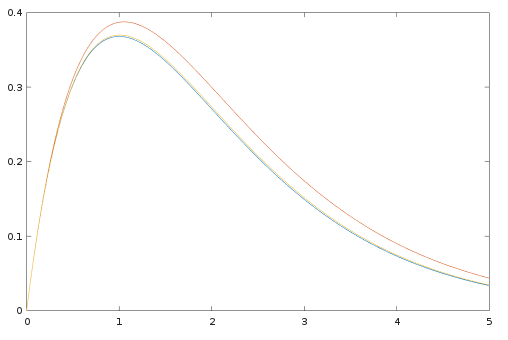In my previous post I illustrated why it is not possible to compute the Jordan canonical form numerically (i.e. in floating point numbers). The simple reason: For every matrix and every
there is a matrix
which differs from
by at most
(e.g. in every entry – but all norms for matrices are equivalent, so this does not really play a role) such that
is diagonalizable. So why should you bother about computing the Jordan canonical form anyway? Or even learning or teaching it? Well, the prime application of the Jordan canonical form is to calculate solutions of linear systems of ODEs. The equation
with matrix and initial value
(both could also be complex). This system has a unique solution which can be given explicitly with the help of the matrix exponential as
where the matrix exponential is
It is not always simple to work out the matrix exponential by hand. The straightforward way would be to calculate all the powers of , weight them by
and sum the series. This may be a challenge, even for simple matrices. My favorite example is the matrix
Its first powers are
You may notice that the Fibonicci numbers appear (and this is pretty clear on a second thought). So, finding a explicit form for leads us to finding an explicit form for the
-th Fibonacci number (which is possible, but I will not treat this here).
Another way is diagonalization: If is diagonalizable, i.e. there is an invertible matrix
and a diagonal matrix
such that
you see that
and the matrix exponential of a diagonal matrix is simply the exponential function applied to the diagonal entries.
But not all matrices are diagonalizable! The solution that is usually presented in the classroom is to use the Jordan canonical form instead and to compute the matrix exponential of Jordan blocks (using that you can split a Jordan block into the sum of a diagonal matrix
and a nil-potent matrix
and since
and
commute one can calculate
and both matrix exponentials are quite easy to compute).
But in light of the fact that there are a diagonalizable matrices arbitrarily close to any matrix, on may ask: What about replacing a non-diagonalizable matrix with a diagonalizable one (with a small error) and then use this one?
Let’s try this on a simple example:
We consider
which is not diagonalizable. The linear initial value problem
has the solution
and the matrix exponential is
So we get the solution
Let us take a close-by matrix which is diagonalizable. For some small we choose
Since is upper triangular, it has its eigenvalues on the diagonal. Since
, there are two distinct eigenvalues and hence,
is diagonalizable. Indeed, with
we get
The matrix exponential of is
Hence, the solution of ,
is
How is this related to the solution of ? How far is it away?
Of course, the lower right entry of converges to
for
, but what about the upper right entry? Note that the entry
is nothing else that the (negative) difference quotient for the derivative of the function at
. Hence
and we get
as expected.
It turns out that a fairly big is already enough to get a quite good approximation and even the correct asymptotics: The blue curve it first component of the exact solution (initialized with the second standard basis vector), the red one corresponds
and the yellow on (pretty close to the blue on) is for
.
to $\e
Leave a comment